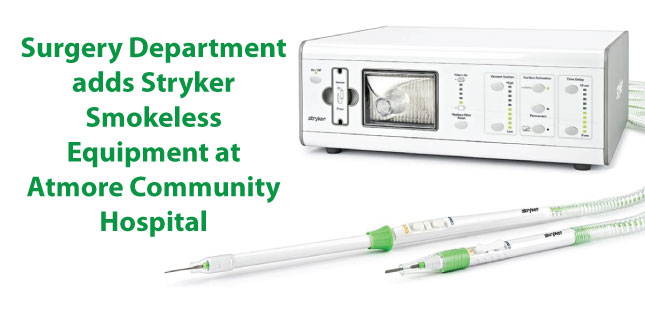 Atmore Community Hospital Adds Stryker Smokeless Surgical EquipmentStryker Smokeless Surgical Equipment
Atmore Community Hospital Adds Stryker Smokeless Surgical EquipmentStryker Smokeless Surgical Equipment
Escambia County (AL) - Atmore Community Hospital Adds Stryker Smokeless Surgical Equipment
Atmore Community Hospital (ACH) announced that their surgery department has upgraded their surgical equipment to now include a Stryker SafeAir Smoke Evacuation System. The new upgrade was put into service April 2021.
"The Stryker SafeAir System makes surgery safer for both the patient and our surgical teams," said Brad Lowery Administrator, ACH. "Though Alabama does not require smoke evacuation systems for surgery, we felt that adding an extra level of safety better aligned with the quality we strive to provide. This is a welcome upgrade to our surgery department and enhances our ability to provide quality general surgery services to our community."
The Stryker SafeAir Smoke Evacuation System was created to reduce surgical smoke particles. These tiny particles are released during the surgery process. Physicians, researchers, workplace safety groups, clinical societies, quality organizations and governments have all scrutinized the potential hazards of surgical smoke. Many of these groups, as well as study authors, suggest the health risk to O.R. staff is greater than any one study or case report due to their cumulative, long-term exposure.
"It is wonderful that we are now able to offer smokeless surgery at ACH", said Rita Gohagin, OR Manager. "Not only do we feel safer knowing there is less of a daily risk to operate where we work, we are also providing another level of safety to our patients, who may not even be aware that surgery smoke is an issue and potential hazard to them."
According to research, one (1) day of O.R. exposure where electrocautery is used in surgery is the equivalent to smoking 27 cigarettes. In addition, there are 150 different chemicals created during various surgeries and O.R. nurses are the highest risk because of their frequent exposure. Studies also conclude that 77 percent of smoke particles are not captured by standard surgical masks and those particles can contain viruses.